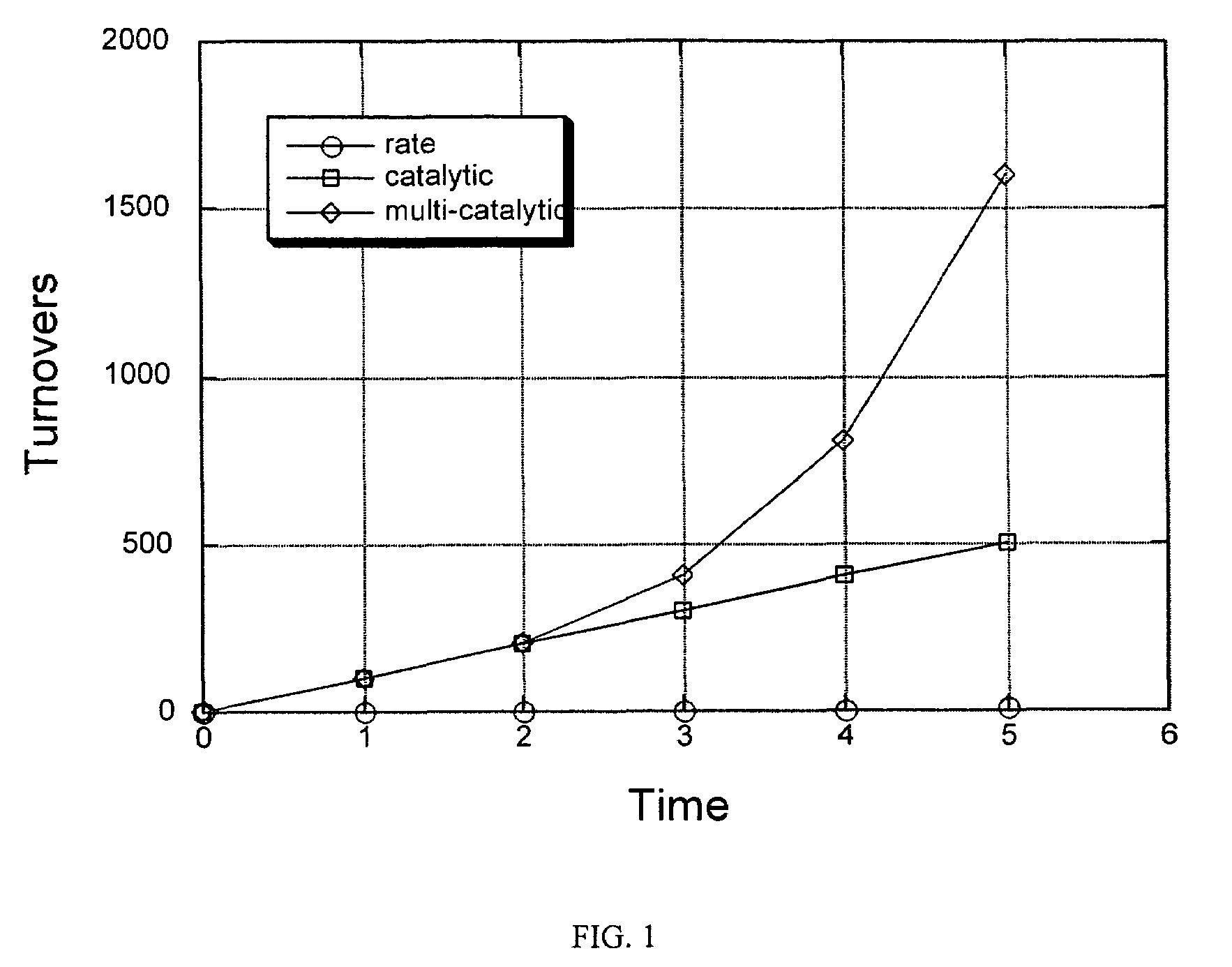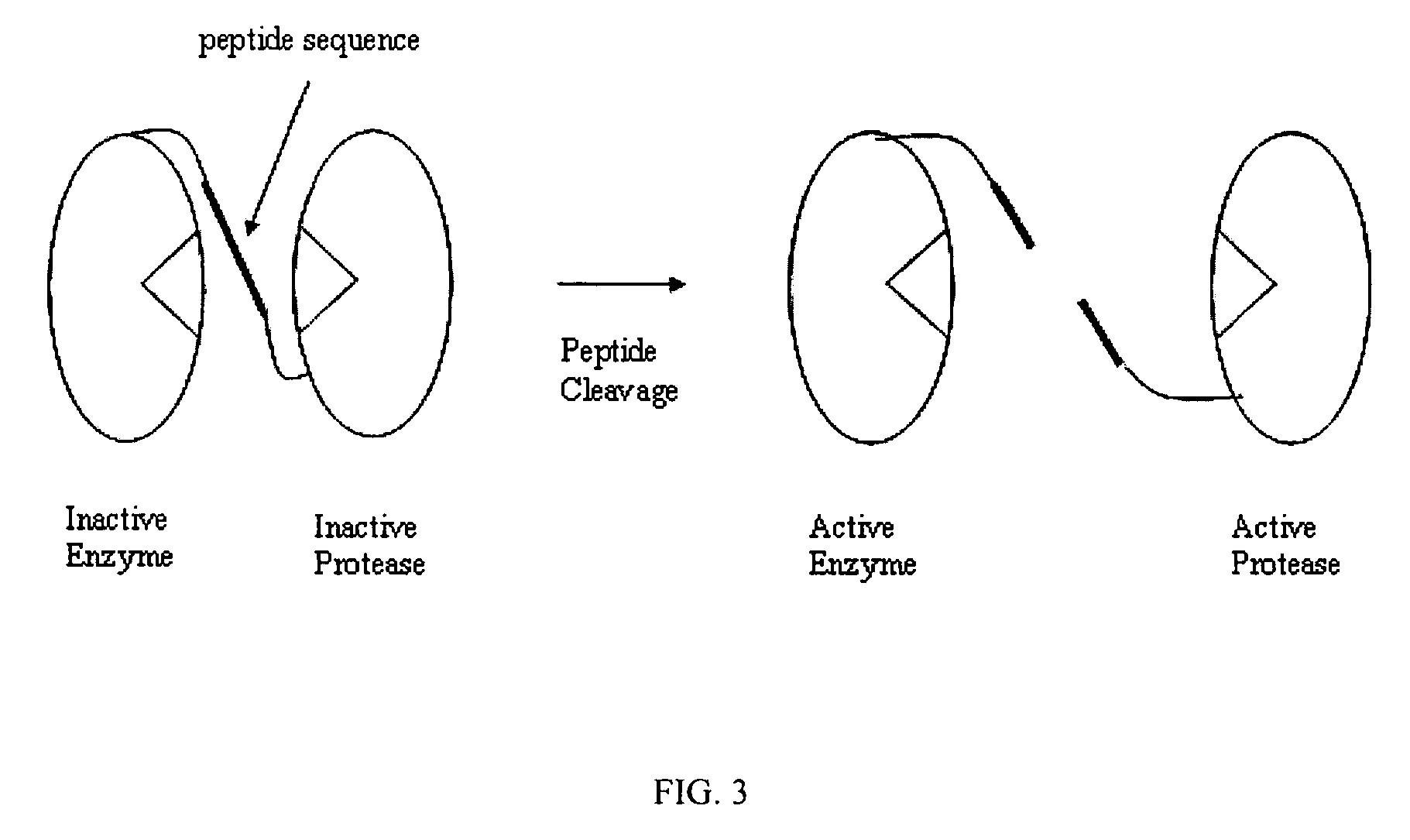Signal amplification using a synthetic zymogen
a synthetic zymogen and signal amplification technology, applied in the field of signal amplification using a synthetic zymogen, can solve the problems of insufficient or slow inability to provide sensitive and fast detection of chemical reactions, and infection, etc., to inhibit the enzymatic activity of the zymogen
- Summary
- Abstract
- Description
- Claims
- Application Information
AI Technical Summary
Benefits of technology
Problems solved by technology
Method used
Image
Examples
example 1
Cloning and Expression of Wildtype and Mutant CotA Variants
[0104]Oligonucleotide primers (illustrated in Table 1) were designed to incorporate an NheI restriction site at the 5′ end and a XhoI site at the 3′ end of the gene during the amplification of CotA variants from Bacillus subtilis (restriction sites are underlined in Table 1). The PCR-amplified fragment was cloned into the NheI / XhoI site of expression vector pET24a (Novagen, San Diego, Calif.) to generate recombinant SSM plasmids (Table 2).
[0105]Colony PCR using a commercially available T7 primer set confirmed the presence of the insert in the recombinant SSM constructs. FIG. 9 illustrates a photograph of the resulting PCR gel, confirming the insertion of 1.7 kb wild-type CotA by PCR. The vector is pET24A, the insert is wild-type CotA, and the primer set used was a commercially available T7 primer set. Lane 7 shows Clone JS6, indicating an insert size of ˜1.542 kb.
[0106]
TABLE 1Oligonucleotide primersPrimerSequenceCotAForCATAT...
example 2
Expression of Wildtype and CotA Variants
[0108]To express the CotA variants, the SSM constructs were transformed into E. coli expression strain BL21DE3. At an optical density at 550 nm of 0.4, the cells were induced by the addition of 1 mM isopropyl-β-D-thiogalactopyranoside (IPTG; Sigma, St. Louis, Mo.) and growth continued at 37° C. for 3 hours. Following induction, 1 ml of the cells was centrifuged and resuspended in 50 μl of PSB (protein sample buffer), boiled for 10 min and electrophoresed at 200V for 1 hour. The expression was confirmed by running a protein sample on a 12% SDS PAGE gel. Overexpression of CotA in clone JS6 was also demonstrated. FIG. 10 illustrates a photograph of the gel showing the overexpression of CotA in clone JS6.
[0109]FIG. 11 illustrates a photograph of a gel demonstrating PCR screening of CotA mutants using T7 primer set. FIG. 12 illustrates a photograph of a gel showing the overexpression of mutant CotA using SSM1 clones.
example 3
ABTS Assay of Wildtype and Mutant Variants of CotA
[0110]The activity of CotA wild type and the mutant variants was determined using an 2,2′-azinobis(3-ethylbenzthiazoline-6-sulfonate) (ABTS) assay. Briefly, 45 μl of the wild type and mutant CotA lysates were incubated with 10 μl of ABTS substrate (2.0 mM) and 45 μl of 1× phosphate buffered saline (PBS). The reaction was followed on a 96 well microtiter plate reader using an wavelength of 415 nm at 37° C. The reaction was monitored for a period of 1 hour (hr) and plotted using the KaleidaGraph software. As expected, the wild type had the highest reactivity to the ABTS substrate when compared to the CotA mutant variants. FIG. 13 illustrates a graph showing that the CotA variants (SSM4-1, SSM1-1, SSM1-3, SSM2-4, and SSM2-6) were partially inhibited by the extensions and modifications of CotA. In FIG. 13, “wt” refers to wild-type, “1-1” refers to SSM1-1, “1-3” refers to SSM1-3, “2-4” refers to SSM2-4, “2-6” refers to SSM2-6, “3-1” refer...
PUM
 Login to View More
Login to View More Abstract
Description
Claims
Application Information
 Login to View More
Login to View More - R&D
- Intellectual Property
- Life Sciences
- Materials
- Tech Scout
- Unparalleled Data Quality
- Higher Quality Content
- 60% Fewer Hallucinations
Browse by: Latest US Patents, China's latest patents, Technical Efficacy Thesaurus, Application Domain, Technology Topic, Popular Technical Reports.
© 2025 PatSnap. All rights reserved.Legal|Privacy policy|Modern Slavery Act Transparency Statement|Sitemap|About US| Contact US: help@patsnap.com



